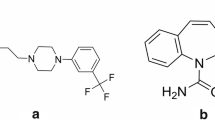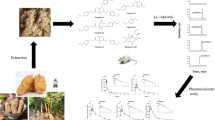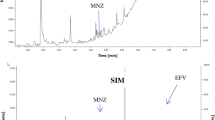Abstract
As a synthetic polymer, methoxy-polyethylene glycol propionic acid (M-PEG-PA) is widely used in the biomedicine field. Unraveling the pharmacokinetic behavior of M-PEG6-PA in vivo is crucial for evaluating the safety and efficiency of M-PEG-PA-related polymers or drug delivery systems. A high-throughput and green ultra-performance convergence chromatography-tandem mass spectrometry (UPC2-MS/MS) assay was firstly developed and validated for the determination of M-PEG6-PA polymers in a biological matrix. The MRM transition (mass to charge ratio, precursor ions→fragment ions) of m/z 367.2→118.9 was used to quantify M-PEG6-PA in this study. The throughput of the assay is high and the total running time for each sample was only 2 min. The linear range of the developed UPC2-MS/MS assay for quantification of M-PEG6-PA in a biological matrix is 0.05 to 30 μg/mL (R≥0.995). Intra-day and inter-day precisions for the determination of M-PEG6-PA by this analytical assay were <6.99%. The absolute recoveries and matrix effects of M-PEG6-PA ranged from 79.50 to 92.47% and 68.72 to 81.73%, respectively. The UPC2-MS/MS assay was successfully applied to quantify the concentrations of M-PEG6-PA polymers in rat plasma samples.
Graphical Abstract












Similar content being viewed by others
Data availability
The datasets generated and analyzed during the current study are available from the corresponding author upon reasonable request.
References
Ibrahim M, Ramadan E, Elsadek NE, Emam SE, Shimizu T, Ando H, et al. Polyethylene glycol (PEG): the nature, immunogenicity, and role in the hypersensitivity of PEGylated products. J Controlled Release. 2022;351:215–30. https://doi.org/10.1016/j.jconrel.2022.09.031.
D’souza AA, Shegokar R. Polyethylene glycol (PEG): a versatile polymer for pharmaceutical applications. Expert Opin Drug Deliv. 2016;13:1257–75. https://doi.org/10.1080/17425247.2016.1182485.
EFSA Panel on Food Additives and Nutrient Sources added to Food (EFSA ANS Panel), Younes M, Aggett P, Aguilar F, Crebelli R, Dusemund B, Filipič M, et al. Refined exposure assessment of polyethylene glycol (E 1521) from its use as a food additive. EFSA J Eur Food Saf Auth 2018;16:05293. https://doi.org/10.2903/j.efsa.2018.5293
Jang HJ, Shin CY, Kim KB. Safety evaluation of polyethylene glycol (PEG) compounds for cosmetic use. Toxicol Res. 2015;31:105–36. https://doi.org/10.5487/TR.2015.31.2.105.
Mohamed M, Abu Lila AS, Shimizu T, Alaaeldin E, Hussein A, Sarhan HA, et al. PEGylated liposomes: immunological responses. Sci Technol Adv Mater. 2019;20:710–24. https://doi.org/10.1080/14686996.2019.1627174.
Swierczewska M, Lee KC, Lee S. What is the future of PEGylated therapies? Expert Opin Emerg Drugs. 2015;20:531–6. https://doi.org/10.1517/14728214.2015.1113254.
Molineux G. Pegylation: engineering improved pharmaceuticals for enhanced therapy. Cancer Treat Rev. 2002;28(Suppl A):13–6. https://doi.org/10.1016/s0305-7372(02)80004-4.
Nel AE, Mädler L, Velegol D, Xia T, Hoek EMV, Somasundaran P, et al. Understanding biophysicochemical interactions at the nano–bio interface. Nat Mater. 2009;8:543–57. https://doi.org/10.1038/nmat2442.
Firdessa R, Oelschlaeger TA, Moll H. Identification of multiple cellular uptake pathways of polystyrene nanoparticles and factors affecting the uptake: relevance for drug delivery systems. Eur J Cell Biol. 2014;93:323–37. https://doi.org/10.1016/j.ejcb.2014.08.001.
Alexis F, Pridgen E, Molnar LK, Farokhzad OC. Factors affecting the clearance and biodistribution of polymeric nanoparticles. Mol Pharm. 2008;5:505–15. https://doi.org/10.1021/mp800051m.
Bai MY, Liu SZ. A simple and general method for preparing antibody-PEG-PLGA sub-micron particles using electrospray technique: an in vitro study of targeted delivery of cisplatin to ovarian cancer cells. Colloids Surf B Biointerfaces. 2014;117:346–53. https://doi.org/10.1016/j.colsurfb.2014.02.051.
Harris JM, Chess RB. Effect of pegylation on pharmaceuticals. Nat Rev Drug Discov. 2003;2:214–21. https://doi.org/10.1038/nrd1033.
Seedher N, Bhatia S. Solubility enhancement of Cox-2 inhibitors using various solvent systems. AAPS PharmSciTech. 2003;4:E33. https://doi.org/10.1208/pt040333.
Xiao F, Wang Z, Li W, Qi W, Bai X, Xu H. Cefepime-modified magnetic nanoparticles and enzymatic colorimetry for the detection of Listeria monocytogenes in lettuces. Food Chem. 2023;409: 135296. https://doi.org/10.1016/j.foodchem.2022.135296.
Soltani S, Sereshti H. A green alternative QuEChERS developed based on green deep eutectic solvents coupled with gas chromatography-mass spectrometry for the analysis of pesticides in tea samples. Food Chem. 2022;380:132181. https://doi.org/10.1016/j.foodchem.2022.132181.
Zamani R, Pilehvar-Soltanahmadi Y, Alizadeh E, Zarghami N. Macrophage repolarization using emu oil-based electrospun nanofibers: possible application in regenerative medicine. Artif Cells Nanomed Biotechnol. 2018;46:1258–65. https://doi.org/10.1080/21691401.2017.1367689.
Ge J, Chen L, Huang B, Gao Y, Zhou D, Zhou Y, et al. Anchoring group-mediated radiolabeling of inorganic nanoparticles─a universal method for constructing nuclear medicine imaging nanoprobes. ACS Appl Mater Interfaces. 2022;14:8838–46. https://doi.org/10.1021/acsami.1c23907.
Zhang P, Sun F, Hung HC, Jain P, Leger KJ, Jiang S. Sensitive and quantitative detection of anti-poly(ethylene glycol) (PEG) antibodies by methoxy-PEG-coated surface plasmon resonance sensors. Anal Chem. 2017;89:8217–22. https://doi.org/10.1021/acs.analchem.7b02447.
Stone CA, Liu Y, Relling MV, Krantz MS, Pratt AL, Abreo A, et al. Immediate hypersensitivity to polyethylene glycols and polysorbates: more common than we have recognized. J Allergy Clin Immunol Pract. 2019;7:1533-1540.e8. https://doi.org/10.1016/j.jaip.2018.12.003.
D’souza AA, Shegokar R. Polyethylene glycol (PEG): a versatile polymer for pharmaceutical applications. Expert Opin Drug Deliv. 2016;13:1257–75. https://doi.org/10.3390/molecules26051435.
Li J, Kao WJ. Synthesis of polyethylene glycol (PEG) derivatives and PEGylated-peptide biopolymer conjugates. Biomacromolecules. 2003;4:1055–67. https://doi.org/10.1021/bm034069l.
Jambo H, Dispas A, Hubert C, Lecomte F, Ziemons É, Hubert P. Generic SFC-MS methodology for the quality control of vitamin D3 oily formulations. J Pharm Biomed Anal. 2022;209:114492. https://doi.org/10.1016/j.jpba.2021.114492.
Bahmany S, Abdulla A, Ewoldt TMJ, Oehlers PL, de Winter BCM, Koch BCP. High-throughput analysis for the simultaneous quantification of nine beta-lactam antibiotics in human plasma by UPC2-MS/MS: method development, validation, and clinical application. J Pharm Biomed Anal. 2022;219:114904. https://doi.org/10.1016/j.jpba.2022.114904.
Wang S, Qi P, Di S, Wang J, Wu S, Wang X, et al. Significant role of supercritical fluid chromatography - mass spectrometry in improving the matrix effect and analytical efficiency during multi-pesticides residue analysis of complex chrysanthemum samples. Anal Chim Acta. 2019;1074:108–16. https://doi.org/10.1016/j.aca.2019.04.063.
Yang F, Tang G, Liu S, Fan Z, Wang Y, Deng H, et al. Ultra-performance convergence chromatography with tandem mass spectrometry-assisted method for rapid enantioseparation and determination of fluazifop-butyl in tobacco and soil. Chirality. 2019;31:353–61. https://doi.org/10.1002/chir.23062.
Yang Z, Xu X, Sun L, Zhao X, Wang H, Fawcett JP, et al. Development and validation of an enantioselective SFC-MS/MS method for simultaneous separation and quantification of oxcarbazepine and its chiral metabolites in beagle dog plasma. J Chromatogr B. 2016;1020:36–42. https://doi.org/10.1016/j.jchromb.2016.03.013.
Kaza M, Karazniewicz-Lada M, Kosicka K, Siemiatkowska A, Rudzki PJ. Bioanalytical method validation: new FDA guidance vs. EMA guideline. Better or worse? J Pharm Biomed Anal. 2019;165:381–5.
Pena-Pereira F, Wojnowski W, Tobiszewski M. AGREE—Analytical GREEnness Metric approach and software. Anal Chem. 2020;92:10076–82. https://doi.org/10.1021/acs.analchem.0c01887.
Manousi N, Wojnowski W, Płotka-Wasylka J, Samanidou V. Blue Applicability Grade Index (BAGI) and software: a new tool for the evaluation of method practicality. Green Chem. 2023;25:7598–604. https://doi.org/10.1039/D3GC02347H.
U.S. Department of Health and Human Services, Food and Drug Administration, Center for Drug Evaluation and Research (CDER), Center for Veterinary Medicine (CVM). Bioanalytical method validation guidance for industry. 2018. http://www.fda.gov/media/70858/download. Accessed 15 Jan 2024.
European Medicines Agency. Guideline on bioanalytical method validation. 2011. http://www.ema.europa.eu/en/documents/scientific-guideline/guideline-bioanalytical-method-validation_en.pdf. Accessed 15 Jan 2024.
Zhou X, Meng X, Cheng L, Su C, Sun Y, Sun L, et al. Development and application of an MSALL-based approach for the quantitative analysis of linear polyethylene glycols in rat plasma by liquid chromatography triple-quadrupole/time-of-flight mass spectrometry. Anal Chem. 2017;89:5193–200. https://doi.org/10.1021/acs.analchem.6b04058.
Hyldbakk A, Hansen T, Hak S, Borgos SEF. Polyethylene glycol (PEG) as a broad applicability marker for LC–MS/MS-based biodistribution analysis of nanomedicines. J Contr Release. 2024;366:611–20. https://doi.org/10.1016/j.jconrel.2024.01.016.
Shi M, Jiang H, Yin L, Liu Y, Xu M. Development of an UPLC-MS/MS method coupled with in-source CID for quantitative analysis of PEG-PLA copolymer and its application to a pharmacokinetic study in rats. J Chromatogr B. 2019;1125:121716. https://doi.org/10.1016/j.jchromb.2019.121716.
Shi M, Zheng X, Ge Y, Zhang N, Yu L, Duan X, et al. Unraveling the cytotoxicity and cellular uptake of low, medium and high molecular weight polyethylene glycol polymers in MCF-7 cells by green UPLC-MS/MS methods. J Pharm Biomed Anal. 2024;238: 115868. https://doi.org/10.1016/j.jpba.2023.115868.
Ge Y, Zhang N, Zheng X, Yu L, Liu Y, Xue H, et al. Ultra-high-performance liquid chromatography with tandem mass spectrometry method for cellular toxicity and pharmacokinetic study of PEG1K polymers. J Sep Sci. 2024;47:2300802. https://doi.org/10.1002/jssc.202300802.
Funding
This work was financially supported by the Fundamental Research Funds for the Central Universities, China (Grant Nos: DUT23YG228, DUT24MS018).
Author information
Authors and Affiliations
Contributions
Chunpeng Feng: writing—original draft, review and editing, methodology, formal analysis, data curation, conceptualization. Jiye Tian: formal analysis, data curation. Qisheng Fang: formal analysis, data curation, writing—review and editing. Yajie Cheng: sample preparation. Yue Deng: sample preparation. Jiarui Zhang: sample preparation. Shuang Feng: validation. Qingbin Wang: project administration. Hecheng Wang: writing—review and editing. Xuan Zhao: project administration. Lei Yin: writing—review and editing, supervision funding acquisition, conceptualization, formal analysis, project administration, investigation.
Corresponding authors
Ethics declarations
Declarations
Three female rats (200±20 g) were obtained from Liaoning Changsheng Biotechnology Co., Ltd. Animal welfare and experimental procedures were performed according to the Guidance for the Care and Use of Laboratory Animals of the National Research Council of USA 1996 and related ethical regulations of Dalian University of Technology.
Conflict of interest
The authors declare no competing interests.
Additional information
Publisher's Note
Springer Nature remains neutral with regard to jurisdictional claims in published maps and institutional affiliations.
Supplementary Information
Below is the link to the electronic supplementary material.
Rights and permissions
Springer Nature or its licensor (e.g. a society or other partner) holds exclusive rights to this article under a publishing agreement with the author(s) or other rightsholder(s); author self-archiving of the accepted manuscript version of this article is solely governed by the terms of such publishing agreement and applicable law.
About this article
Cite this article
Feng, C., Tian, J., Fang, Q. et al. Development and validation of a high-throughput and green ultra-performance convergence chromatography-tandem mass spectrometry assay for quantification of methoxy-polyethylene glycol propionic acid polymers. Anal Bioanal Chem (2025). https://doi.org/10.1007/s00216-025-05849-5
Received:
Revised:
Accepted:
Published:
DOI: https://doi.org/10.1007/s00216-025-05849-5




